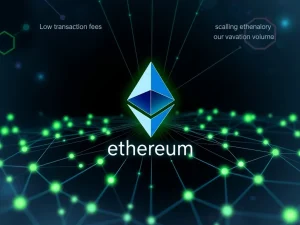Ethereum Fusaka Upgrade: A Transformative Leap for Scalability and Efficiency

The cryptocurrency world anticipates a significant advancement with the upcoming **Ethereum Fusaka upgrade**. This crucial hard fork promises to enhance the network’s capabilities, aiming for greater efficiency and lower transaction costs. Scheduled for early December, Fusaka introduces pivotal changes that will impact users and developers alike. Furthermore, it sets the stage for a more robust and scalable Ethereum ecosystem.
Ethereum Fusaka Upgrade: Boosting Network Scalability
Ethereum’s core developers have selected December 3 as the tentative launch date for the Fusaka hard fork. This significant update will introduce 12 Ethereum Improvement Proposals (EIPs) designed to boost the network’s overall performance. Specifically, these EIPs target enhanced **Ethereum scalability**, improved security measures, and reduced transaction costs. The move represents a continuous effort to evolve the Ethereum blockchain.
This deployment follows the successful Pectra upgrade on May 7. The Pectra upgrade notably raised the validator staking limit, introduced account abstraction, and made layer-2 networks more efficient. Consequently, Fusaka builds upon these foundations, pushing Ethereum’s capabilities even further. Developers plan to conduct three public testnets between early October and mid-November. These testnets ensure the upgrade’s stability and readiness before its mainnet deployment.
Doubling Ethereum Blobs: A New Era for Layer-2s
A cornerstone of the **Ethereum Fusaka upgrade** involves a substantial increase in blob capacity. Blobs are crucial data segments that store large datasets off-chain. This mechanism significantly enhances the efficiency of layer-2 networks. It also plays a vital role in decreasing transaction costs for users. The initial increase in blob capacity will occur approximately two weeks after the Fusaka launch, around December 17.
Another significant blob capacity hard fork is planned for January 7, 2026. Both these Blob Parameter Only (BPO) hard forks will more than double the current blob capacity. Ethereum researcher Christine D. Kim confirmed these plans. Developers anticipate a total of five BPOs for Fusaka. This phased approach ensures the mainnet scales safely and effectively. Currently, the average blob count per block stands at 5.1, a notable increase from 0.9 in March 2023, according to a Dune dashboard. This rising usage underscores the growing importance of **Ethereum blobs** for network operations.
Understanding the Hard Fork Timeline and Security
The timeline for Fusaka’s deployment is meticulously planned. The initial launch on December 3 will be followed by subsequent BPO stages. These stages are critical for gradually increasing blob capacity. BPO (Blob-Parameter Only) forks specifically adjust parameters related to blob targets and limits. Importantly, these types of hard forks do not necessitate any client-side updates, simplifying the transition for network participants.
Security remains a paramount concern for any major network upgrade. To ensure the integrity of the Fusaka codebase, the Ethereum Foundation announced a four-week code audit program. This initiative offers $2 million to developers who successfully discover and disclose vulnerabilities. Such rigorous auditing is essential for maintaining the trustworthiness and stability of the network, especially during a significant **hard fork** event. This proactive security measure demonstrates the commitment to a secure and reliable Ethereum ecosystem.
ETH Staking and the Exit Queue Dynamics
Amidst the anticipation for Fusaka, the **ETH staking** landscape has seen recent activity. The amount of ETH unstaked by Ethereum’s validators reached an all-time high last week. Approximately 2.6 million ETH, valued at $12 billion, entered the exit queue. This surge raised concerns among some market participants regarding potential selling pressure.
Conversely, the queue to enter the staking pool recorded a four-week low. The current wait time for the exit queue stands at around 43 days, as reported by the Ethereum Validator Queue. Ethereum co-founder Vitalik Buterin addressed these concerns. He argued that the protocol’s lengthy exit queue exists for a crucial reason. Lowering this limit, he stated, would make the chain “much less trustworthy.” Buterin’s comments responded to criticisms, including those from Galaxy Digital’s head of DeFi, Michael Marcantonio, who called the exit queue length “troubling.” This ongoing discussion highlights the delicate balance between liquidity and network security within the **ETH staking** mechanism.
The Future of Ethereum Scalability
The **Ethereum Fusaka upgrade** represents a vital step in Ethereum’s ongoing evolution. By doubling blob capacity and implementing 12 key EIPs, the network significantly enhances its ability to handle more transactions. This improvement directly addresses the growing demand for efficient and cost-effective blockchain operations. Ultimately, these advancements reinforce Ethereum’s position as a leading platform for decentralized applications and layer-2 solutions.
The continuous focus on **Ethereum scalability** through planned hard forks and robust security audits demonstrates a strong commitment from its core developers. As the network matures, these upgrades are indispensable for fostering innovation and widespread adoption. The Fusaka upgrade, therefore, is not merely a technical update; it is a strategic move towards a more accessible and powerful decentralized future.








